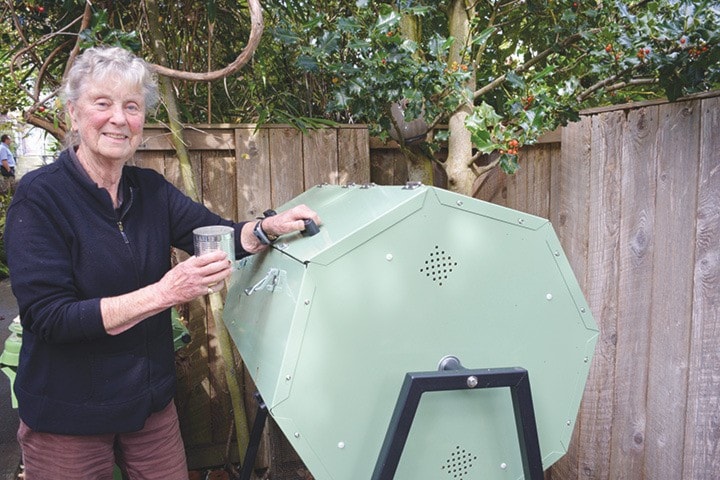Mid-way through the municipality’s composting pilot project, response is generally positive to the initiative.
Earlier this year, the municipality launched the project to have a cross-section of residents test-drive a Jora composter, an insulated metal composter positioned on a stand to it’s off the ground and can be turned to speed the compost process.
The district selected two representative areas of the municipality and asked residents to use the composters.
The idea was to get a fair presentation, ranging from those keen on the idea to those not so keen. “We want to really be as representative as possible,” said David Brozuk, Oak Bay’s superintendent of public works.
Fifty households are participating in the pilot, with about 60 per cent happy with the point-of-source composting one area and 90 per cent in the other.
While it’s still early in the process, and while information is anecdotal at this point, “people are quite impressed with how quickly it breaks down, the odour is quite low and there are no pests,” Brozuk said.
An initial survey of participants will likely happen this fall, with follow-up interviews scheduled for the new year, followed by a report to council. Two UVic students are working with Oak Bay in the evaluation.
The initiative has its roots with Oak Bay resident Hally Hofmeyr, who was looking for a better solution to his former backyard composter that was inefficient in our climate and tended to attract rats.
Hofmeyr purchased the Jora composter from Russ Chambers about 3 1/2 years ago.
“I was looking for a composter that would fit our climate,” he explains. This one “works like a dream; in the middle of January, I’m composting.”
The units come in three sizes, are insulated, secure and spin, which encourages the organic materials to break down quickly. “All you need for composting is air and heat,” Chambers said.
Over the last four years, Jora has “sold composters from Dawson Creek to Los Angeles,” he said.
Hofmeyr sees the composters as a workable, user-friendly and economically viable solution to the Capital Regional District’s current need to transport materials off Island for processing.
Oak Bay budgeted $282,000 this year to transport compost from residences to the Lower Mainland for treatment. Oak Bay residents produce 55 metric tones of compostable materials per month, Brozuk said.
Oak Bay Coun. Tara Ney was also on hand for Chambers’ recent visit to the home of resident and pilot study participant Alison Leamy.
“The evaluation is one important source of information about the economic viability to do some comparison to the existing program and what this will do to mitigate costs and also receptivity to the program,” Ney said.
Leamy has been test-driving her composter since the start of the pilot project and noted the simplicity of the process. She saves any food waste and eggshells in a small container, then takes it out the backdoor to the composter as needed. A bucket of wood pellets sits underneath and she adds a scoop every so often to encourage the additions to break down. The ratio is about 10-1, pellets to kitchen waste.
The bins will accept virtually all kitchen and garden waste, with bones being the only thing that can be challenging to break down.
The compost is then used around the garden.
“Compost encourages aeration to the roots and creates warmth in the winter for the roots, and provides nutrients from what you put in there,” said Leamy, a home gardener and one of the volunteer supervisors at Government House gardens.
Additional public compost bins like those in the study are located at Windsor Park, Henderson Park and adjacent to municipal hall.
